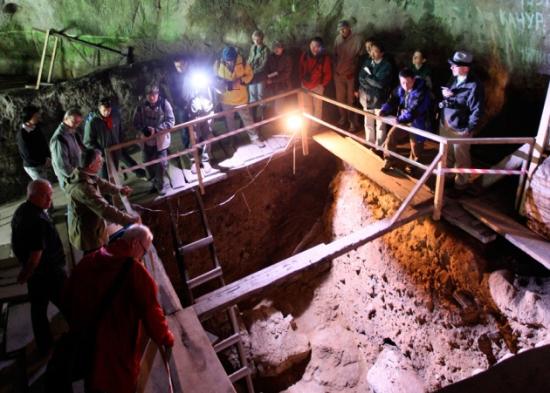Mystery humans spiced up ancients’ sex lives
Ewen Callaway
Source - http://www.nature.com/news/mystery-humans-spiced-up-ancients-sex-lives-1.14196

An excavation in Denisova cave in Siberia, Russia, where remains of Denisovan hominins were first discovered. RIA NOVOSTI/SPL
Updated genome sequences from two extinct relatives of modern humans suggest that these ‘archaic’ groups bred with humans and with each other more extensively than was previously known.
The ancient genomes, one from a Neanderthal and one from a member of an archaic human group called the Denisovans, were presented on 18 November at a meeting on ancient DNA at the Royal Society in London. The results suggest that interbreeding went on between the members of several ancient human-like groups in Europe and Asia more than 30,000 years ago, including an as-yet-unknown human ancestor from Asia.
“What it begins to suggest is that we’re looking at a Lord of the Rings-type world — that there were many hominid populations,” says Mark Thomas, an evolutionary geneticist at University College London who was at the meeting but was not involved in the work.
The first published Neanderthal1 and Denisovan2 genome sequences revolutionized the study of ancient human history, not least because they showed that these groups bred with anatomically modern humans, contributing to the genetic diversity of many people alive today.
Mixed heritage
All modern humans whose ancestry originates outside of Africa owe about 2% of their genome to Neanderthals. Certain populations living in Oceania, such as Papua New Guineans and Australian Aboriginals, share about 4% of their DNA with Denisovans, members of a group named after a cave in the Altai Mountains in Siberia, Russia, where they were discovered. The cave contains remains deposited between 30,000 and 50,000 years ago.

The analysis included 'snippets' of the mystery DNA - neither human nor Neanderthal
At the meeting, however, David Reich, an evolutionary geneticist at Harvard Medical School in Boston, Massachusetts, who worked on those studies, said that the conclusions were based on low-quality genome sequences, riddled with errors and full of gaps. His team, along with collaborator Svante Pääbo at the Max Planck Institute for Evolutionary Anthropology in Leipzig, Germany, has now produced much more complete versions of the Denisovan and Neanderthal genomes — matching the quality of contemporary human genomes. These high-quality Denisovan and Neanderthal sequences are both based on bones from the Denisova Cave.
The Denisovan genome indicates that the population got around: Reich said at the meeting that as well as interbreeding with the ancestors of Oceanians, they also bred with Neanderthals and the ancestors of modern humans in China and other parts of East Asia. Most surprisingly, Reich said, the genomes indicate that Denisovans interbred with yet another extinct population of archaic humans that lived in Asia more than 30,000 years ago — one that is neither human nor Neanderthal.
The meeting was abuzz with conjecture about the identity of this unknown population of humans. “We don’t have the faintest idea,” says Chris Stringer, a paleoanthropologist at the Natural History Museum in London, who was not involved in the work. He speculates that the population could be related to Homo heidelbergensis, a species that left Africa around half a million years ago and later gave rise to Neanderthals in Europe. “Perhaps it lived on in Asia as well,” says Stringer.
- Nature
- doi:10.1038/nature.2013.14196
References
-
Green, R. E. et al Science 328, 710–722 (2010).
-
Meyer, M. Science 338, 222–226 (2012).